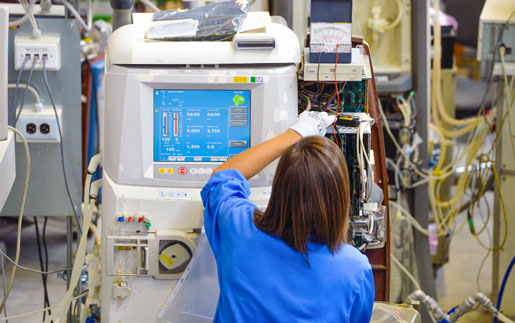Understanding both commercial and on-chip graphics cards will help designers optimize long-term performance.Martin Rudloff
July 27, 2015

Arenas like oncology, orthopedics, obstetrics, and cardiology are relying on enhanced imaging technology in all phases of the healthcare spectrum, from clinical research to real-time patient diagnosis and treatment. |
Medical imaging is a volatile arena—changing rapidly, filling gaps in medical knowledge and becoming an essential factor in improving patient diagnosis and treatment. Quickly advancing from high-resolution imaging to 3-D volumetric scans, sophisticated graphics are at the core of many new healthcare improvements. For medical designers and OEMs, the jump to 3-D may be unfamiliar territory and more complex than anticipated, in that it requires an understanding of commercial graphics components as part of an embedded design strategy. To capitalize on the long-term promise of 3-D imaging, a greater focus on materials planning is crucial during the earliest stages of strategic development, ensuring the ideal balance between peak performance and system availability, longevity, and consistency.
Commercial Graphics Cards Lead in 3-D Performance
A regular pace of x86 advancements has improved on-chip graphics, yet the graphics features on fourth-generation Intel Core processors are optimized only for 2-D media applications such as high-resolution imaging or playback of high-definition video. As medical applications are starting to demand more, newer commercial graphics cards provide an alternative that does not bottleneck CPU resources. These are developed specifically for 3-D graphics performance and function almost like a math coprocessor supplementing CPU performance by directly handling the extreme computing calculations necessary for complex 3-D visualization. Volumetric data such as the size, shape, and depth of a tumor can be depicted in three dimensions, adding rather than subtracting information for the medical practitioner accustomed to seeing this data reduced to the flat format of an x-ray or image scan.
|
Corvalent’s CorSys family of 4U rackmount systems are optimized for healthcare settings that require 3-D image visualization for improved diagnostics and patient treatment. Benchmarks from Nvidia validate that running PhysX on a mid-to-high-end GeForce GPU enables 10–20 times more effects and visual fidelity compared to running it on a CPU. |
This sophisticated medical imaging technology relies on components originally intended for the gamer or maker market. Commercial graphics cards offer some of the strongest performance available; however, it’s their average one-year lifecycle that leaves embedded designers cold. With arduous advance planning, system performance can be maintained for a multiyear, extended medical deployment—but not without causing significant sustaining engineering costs.
Long Life Commercial Options Add Embedded Value
Long-life commercial cards—available from leading global suppliers such as Nvidia—provide an alternative but are potentially unfamiliar to embedded designers because they are relatively new to the market. Long life in commercial terms is perhaps three years and does come at a higher cost than a regular commercial card. But here’s where designers need to think in more traditional embedded design terms: Cost may be an initial factor, but longer life cards reduce operating costs over a long-term medical deployment.
Consider that new software specifications, tools, or compilers may be needed to accommodate a card upgrade. If necessary, software recertification is often more challenging and costly than hardware certification processes. By choosing a commercial card with a three-year lifecycle, developers reduce engineering and design challenges over the system lifetime. In particular, this choice adds essential value in minimizing lengthy FDA recertifications required with each product update.
It’s also important to note that designing with card-based graphics is a commitment – developing systems incorporating Nvidia’s CUDA core and proprietary PhysX technology requires a different skillset than working with the OpenCL technology found in other graphics solutions. Many 3D applications only support PhysX, recognized for its ability to enable simulated image effects without impacting CPU performance. Once designing with PhysX, developers are typically on a long-term path to remain with performance enabled by Nvidia’s GeForce or longer-life Quadro product families.
System Longevity is in the Details
Reliance on commercial components requires planning for obsolescence in the initial steps of the design phase. Early collaboration with manufacturing partners assures the most flexible stocking programs, which can vary extensively according to specific OEM needs, volumes, and requirements. Parts can be purchased based simply on OEM forecasts; or bonded programs can source, stock, and hold components based on the OEM’s purchase order as well as forecast. When more secure partner stocking programs are required—common to components with very short lifecycles—developers may opt for purchase-order-based, noncancellable procurements.
Most importantly, developers and OEMs must explore the requirements for creating a long-term bonded product, asking all the right questions as part of the overall design strategy. Manufacturing partnerships are essential in supporting this aspect of the design process, capitalizing on close supplier relationships to ensure advance notice of end-of-life and ideal strategies for effective, consistent component management.
Blending Commercial Graphics with Embedded Strategies
Three-dimensional imaging is steadily improving healthcare treatment options and is poised to make an even bigger difference as sophisticated graphics-based applications prevail in in clinical decision-making. For developers, understanding both commercial and on-chip options will help optimize long-term performance and bring new value to the complex and competitive medical design process.
Three-dimensional capabilities are not called out in Intel’s embedded roadmap, and new, longer life graphics cards from the commercial realm are filling the gap. While more costly upfront, they have the potential to reduce long-term total cost of ownership and ensure a smooth path for upgrades and continued evolution of 3-D applications in existing systems. With planning and design strategies that capitalize on technical and experienced manufacturer support, medical OEMs and developers can ensure longevity, consistency, and availability of 3-D graphics in long-term healthcare deployments.
Learn how to integrate personalized medicine into your next medical device design at the MEDevice San Diego conference, September 1–2, 2015. |
Martin Rudloff is chief technology officer at Corvalent.
[Images courtes of CORVALENT]
You May Also Like



